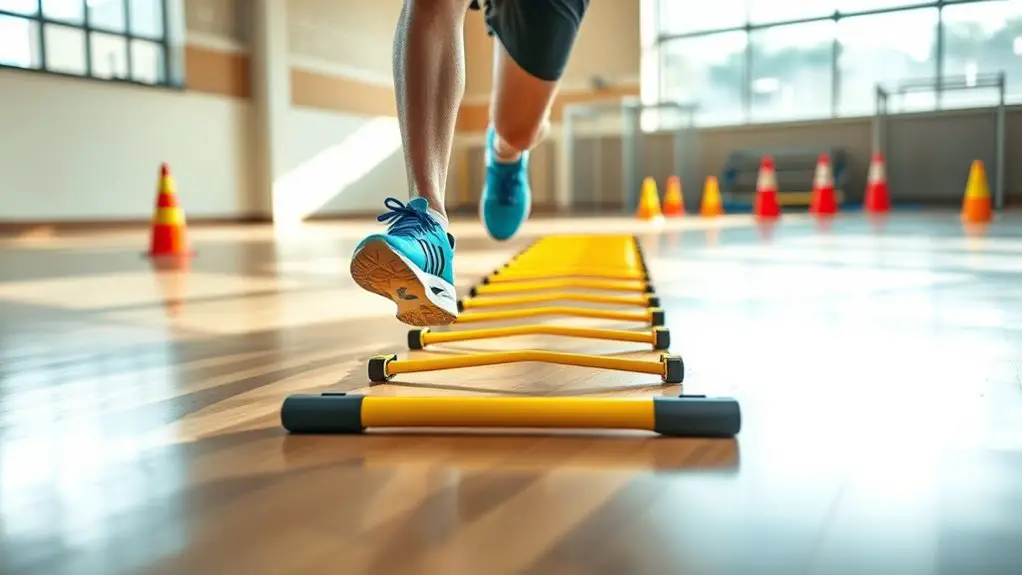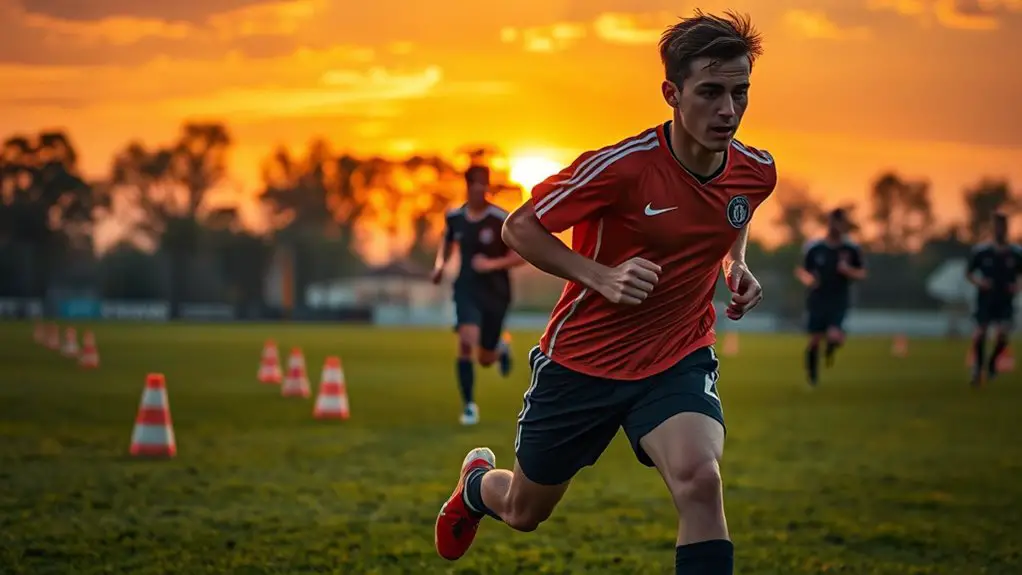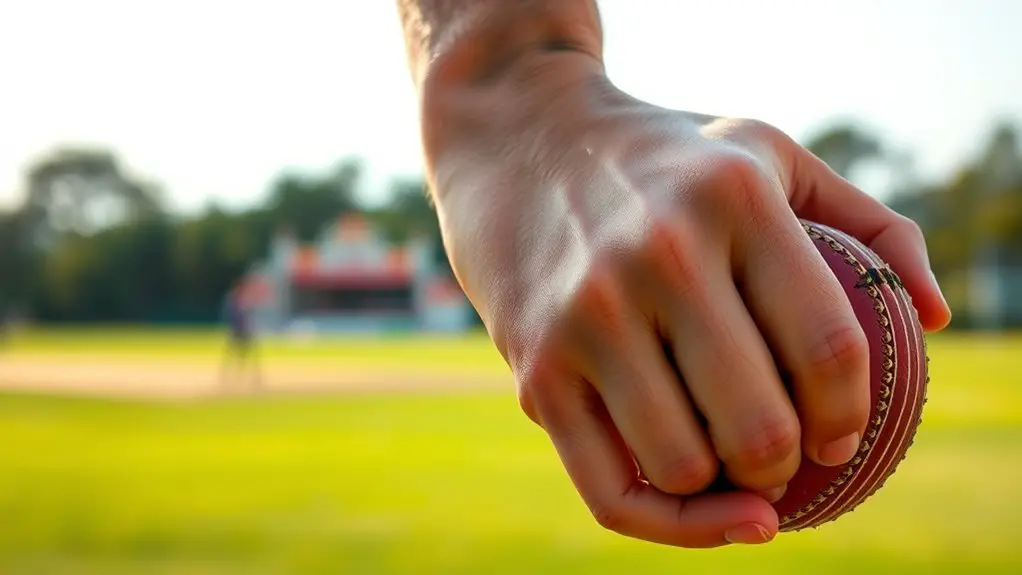If you want to improve your quick footwork, ladder drills are a game-changer. Focus on the One-Foot In, One-Foot Out Drill to sharpen your rhythm, and try the Lateral Shuffle Drill for better agility and balance. The Ickey Shuffle is fantastic for coordination, while the Cross-Over Steps Drill enhances lateral movement. Don't forget the In-and-Out Drill and the Ladder Hop Drill to boost speed and power. Keep going, and you'll discover even more effective techniques to elevate your performance.
Understanding the Importance of Ladder Drills
Ladder drills are a game-changer when it comes to enhancing quick footwork. They're not just about speed; they're about agility, coordination, and control. When you engage in these drills, you're liberating your body to move with precision and confidence. You'll notice improvements in your overall athleticism, allowing you to navigate the field or court with ease.
By integrating ladder drills into your routine, you're building a solid foundation for explosive movements. Your footwork becomes sharper, enabling you to change direction swiftly and react instinctively. This freedom of movement is essential, whether you're playing sports or just enjoying an active lifestyle.
Moreover, you're not just training your legs; you're sharpening your mind. The focus and rhythm required in ladder drills cultivate a sense of awareness that translates into other areas of your performance. Additionally, the consistent practice of agility ladder drills can lead to significant improvements in athletic performance. So, embrace the freedom ladder drills provide and release your full potential.
Basic Ladder Drill Techniques
To get the most out of your ladder drills, you'll want to start with proper ladder placement. Make sure it's flat and stable, so you can focus on your footwork without any distractions. We'll also cover some essential footwork form tips to help you maximize your speed and agility. Incorporating agility training techniques into your routine will further enhance your performance on the court or field.
Proper Ladder Placement
When setting up your agility ladder, proper placement is essential for maximizing your training effectiveness. First, choose a flat, even surface to prevent any slips or stumbles. You want to create a space where you can move freely, so avoid overcrowding the area with obstacles. Position the ladder parallel to your intended direction of movement, ensuring it's secure and won't shift during drills. If you're training outdoors, consider the wind's direction; you don't want it pushing you off course. Finally, keep the ladder at a comfortable length for your stride—too long or too short can hinder your flow. By paying attention to these details, you'll enhance your agility training and enjoy a more liberating experience.
Footwork Form Tips
Proper footwork is essential for maximizing the benefits of agility ladder drills. When you're on the ladder, focus on your form to boost your speed and coordination. Here are some tips to keep in mind:
- Keep your knees slightly bent to maintain balance.
- Use the balls of your feet to stay light and quick.
- Engage your core to stabilize your movements.
- Focus on rhythm; find a consistent pace that works for you.
One-Foot In, One-Foot Out Drill
The One-Foot In, One-Foot Out drill is a fantastic way to enhance your agility and foot speed. This drill will let you explore your body's movement potential while having fun. Start by facing the ladder and placing one foot in each square, alternating feet as you go.
Here's a quick breakdown of the drill:
| Step | Action | Tips |
|---|---|---|
| 1 | Start with one foot inside | Keep your core engaged |
| 2 | Switch feet quickly | Stay light on your toes |
| 3 | Repeat for time or reps | Focus on rhythm |
| 4 | Increase speed gradually | Challenge yourself |
As you progress, try to increase your pace without losing form. This drill not only boosts your speed but also adds a playful element to your workouts. Embrace the freedom of movement and enjoy the challenge! Additionally, mastering this drill can lead to improved agility and coordination, enhancing your overall athletic performance.
Lateral Shuffle Drill
The Lateral Shuffle Drill is a fantastic way to improve your agility and footwork. You'll learn the proper technique to maximize its benefits and explore variations that can elevate your training. Let's break down how to perform this drill effectively and take your skills to the next level. Incorporating this drill into your routine can lead to improved quick directional changes and enhance your overall performance on the court.
Benefits of Lateral Shuffle
Lateral shuffle drills are a powerful tool for enhancing your agility and footwork. They offer a range of benefits that can elevate your performance, whether you're an athlete or just looking to stay active. Here's why you should incorporate them into your routine:
- Improves lateral movement: You'll develop quicker side-to-side motion, essential for many sports.
- Boosts coordination: Your body learns to move efficiently, syncing your feet and legs.
- Increases endurance: The repetitive nature of shuffles can build stamina, keeping you energized longer.
- Enhances balance: You'll gain better control over your body, reducing the risk of injuries.
Embrace the freedom of movement that comes with mastering lateral shuffles, and watch your agility soar!
Proper Technique Overview
To effectively execute the lateral shuffle drill, focus on three key elements: stance, movement, and foot placement. Start by positioning your feet shoulder-width apart, knees slightly bent, and your weight balanced. This relaxed stance allows for quick lateral movement. As you begin, push off with your outside foot while bringing your inside foot to meet it. Keep your hips low and eyes forward, maintaining an athletic posture. Your feet should land softly, ensuring minimal impact while staying light and agile. Remember to engage your core for stability. As you shuffle, keep the rhythm steady, allowing your body to move fluidly through the ladder. This technique not only enhances your quickness but also builds the foundation for more complex drills.
Variations for Advanced Training
While mastering the basic lateral shuffle is essential, incorporating variations can elevate your footwork skills to the next level. By adding these advanced drills, you'll challenge your body and improve your agility, speed, and coordination.
- Single-Leg Lateral Shuffle: Shift your weight to one leg while performing the shuffle, enhancing balance and strength.
- Cross-Over Shuffle: Use a cross-over step to engage more muscles and increase lateral speed.
- Backpedal Shuffle: Combine shuffling with backward movement to train for quick shifts.
- Weighted Lateral Shuffle: Hold weights to increase resistance, pushing your limits and building strength.
Integrating these variations not only keeps your training fresh but also helps you develop the quick footwork necessary for any sport or activity. Enjoy the freedom to explore!
Ickey Shuffle Drill
The Ickey Shuffle Drill is a fantastic way to enhance your footwork and agility, especially if you want to improve your quickness on the field. To perform this drill, start by standing at the edge of the ladder. Step into the first box with your right foot, then quickly bring your left foot in, following with your right foot stepping out to the side. Repeat this sequence, moving down the ladder while maintaining a rhythmic motion.
Focus on keeping your knees high and landing softly to maximize control. You'll notice that the drill not only hones your foot speed but also improves your coordination. Additionally, incorporating ladder drills into your routine can significantly transform your footwork and overall agility.
Feel free to increase your pace as you get comfortable, and don't hesitate to add variations, like changing directions or incorporating arm movements. Embrace the freedom of movement, and let your body flow through the drill. You'll be amazed at how quickly your footwork evolves!
Forward and Backward Ladder Run
Engage your legs and core with the Forward and Backward Ladder Run, a dynamic drill that boosts your speed and agility. This exercise isn't just about moving fast; it's about enhancing your overall footwork and balance. You'll feel empowered as you master this rhythm, allowing for quick shifts during any sport or activity.
Elevate your speed and agility with the Forward and Backward Ladder Run, mastering footwork for any sport or activity.
Here's how to get the most out of the drill:
- Start by facing the ladder, stepping into the first square with one foot.
- Quickly follow with the other foot, then move to the next square.
- After reaching the end, turn around and run backward through the ladder.
- Keep your knees high and maintain a steady pace for maximum effectiveness.
Incorporate this drill into your routine, and you'll notice improved quickness and confidence on the field or court. Embrace the freedom that comes with agile footwork! Additionally, this drill can be complemented by enhanced cardiovascular endurance, which further supports your overall athletic performance.
Cross-Over Steps Drill
The Cross-Over Steps Drill is a fantastic way to improve your footwork and agility. You'll need to focus on proper technique to get the most out of this exercise, and there are several variations you can try to keep things interesting. Let's explore the benefits and tips for mastering this essential drill. Additionally, incorporating functional strength training into your routine can further enhance your agility and overall athletic performance.
Benefits of Cross-Over Steps
While many drills focus on straight-line speed, cross-over steps offer unique benefits that can significantly enhance your agility and footwork. This drill helps you break free from linear movement, allowing you to navigate around obstacles with grace and speed. Here are some key advantages:
- Improved Lateral Movement: Boosts your ability to quickly change direction.
- Enhanced Balance: Strengthens your stability and control during dynamic movements.
- Increased Coordination: Develops better timing between your feet and body.
- Versatility: Useful for various sports and activities where quick footwork is essential.
Incorporating cross-over steps into your routine can lead to a more agile and responsive performance, giving you the freedom to excel in your chosen sport. So, give them a try!
Proper Technique Guide
Mastering the cross-over steps drill requires a few essential techniques to maximize your effectiveness. Start by positioning yourself at the ladder's edge, feet shoulder-width apart. As you step into the first box, use your outside foot to cross over and land in the next space. Keep your knees slightly bent and maintain a low center of gravity. Focus on quick, controlled movements, letting your arms assist in balance.
| Key Technique | Description |
|---|---|
| Foot Placement | Guarantee proper alignment in each box. |
| Body Control | Stay low and centered for agility. |
| Arm Coordination | Use arms for balance and momentum. |
With practice, you'll enhance your footwork and agility effortlessly.
Variations to Try
Incorporating variations into the cross-over steps drill can greatly enhance your footwork training. By mixing things up, you'll not only keep it interesting but also challenge your body in new ways. Here are some variations to try:
- Lateral Cross-Over: Move sideways instead of forward, engaging different muscle groups.
- Backward Cross-Over: Step back into the ladder, improving your agility in reverse.
- Single-Leg Cross-Over: Balance on one leg while crossing over, boosting stability and coordination.
- Speed Challenge: Increase your pace and challenge your reaction time for a more intense workout.
Experimenting with these variations will help you find your flow and develop quick, responsive footwork. Enjoy the freedom of movement and watch your skills soar!
In-and-Out Drill
The In-and-Out Drill is a fantastic way to enhance your footwork agility, as it challenges you to quickly move in and out of the ladder rungs. Start by positioning yourself at one end of the ladder, facing forward. As you step into the first rung with one foot, let your other foot follow, landing inside the rung. Then, step out to the side, returning to your starting position. Keep alternating feet as you move down the ladder, aiming for speed while maintaining control.
This drill isn't just about speed; it's about rhythm and coordination too. Focus on keeping your movements light and bouncy, almost like dancing. The more you practice, the more fluid your footwork will become, giving you the freedom to maneuver effortlessly during any activity. Incorporating balance training, such as core strength, can further enhance your agility and confidence on the move. Whether you're playing sports or just enjoying life, this drill can boost your agility and confidence on the move.
Ladder Hop Drill
While you might think footwork drills are all about speed, the Ladder Hop Drill proves that power and precision are just as essential. This drill hones your ability to control your body while maintaining explosive movements. You'll not only enhance your agility but also develop strength in your legs and core. Incorporating this drill regularly will also benefit your overall performance by improving neuromuscular control for fluid movement.
To get the most out of the Ladder Hop Drill, keep these tips in mind:
- Stay light on your feet: Focus on quick, controlled hops.
- Engage your core: Maintain stability while jumping.
- Use your arms: They'll help with balance and momentum.
- Set a rhythm: Consistent pacing improves coordination.
Incorporating the Ladder Hop Drill into your routine will empower you to navigate the field or court with confidence. So, let loose and enjoy the freedom of movement that comes with mastering this drill!
Incorporating Ladder Drills Into Your Training Routine
To improve your overall athletic performance, integrating ladder drills into your training routine can make a significant difference. Start by setting aside just 10 to 15 minutes a few times a week to include these drills. You don't need fancy equipment; a simple agility ladder will do. Mix in a variety of drills, like the In-Outs and Lateral Shuffles, to keep things interesting and challenge different muscle groups.
Be sure to focus on form and speed, but don't forget to have fun with it! You can even invite friends for a little friendly competition. As you progress, feel free to increase the complexity or speed of the drills. This way, you're not just enhancing your footwork; you're also boosting your overall agility and coordination. Additionally, incorporating agility training techniques into your regimen will further complement your ladder drills. Embrace the freedom of movement and watch your performance soar as you incorporate these drills into your routine!
Frequently Asked Questions
What Equipment Do I Need for Ladder Drills?
For ladder drills, you'll need an agility ladder, which is lightweight and portable. You might also want some cones or markers to set boundaries. Comfortable athletic shoes will enhance your performance and prevent injuries. Enjoy your workout!
How Often Should I Practice Ladder Drills?
You might think practicing ladder drills daily is too much, but consistency is key. Aim for three to four times a week, allowing your body to adapt while enjoying the freedom of movement and skill improvement.
Can Ladder Drills Improve Agility in Other Sports?
You'll find that ladder drills can greatly enhance your agility in various sports. They improve foot speed and coordination, helping you react quicker on the field or court. Keep practicing, and you'll see the difference!
Are Ladder Drills Suitable for Beginners?
Absolutely, ladder drills are perfect for beginners. Just like a dancer finds rhythm, you'll discover your own pace, building coordination and confidence. They're simple, fun, and will liberate your footwork skills in no time.
How Can I Track My Progress With Ladder Drills?
To track your progress with ladder drills, keep a workout journal. Note your times, accuracy, and any improvements. You could also film your sessions, allowing you to visually assess your technique and speed over time.




